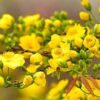The Changing Colors of Flowers Across Seasons and Their Impact on Human Mood
Flowers, with their vibrant hues and captivating beauty, undergo a mesmerizing transformation of colors as the seasons change. From the vibrant blooms of spring to the warm tones of summer and the rich hues of autumn, the shifting colors of flowers evoke a myriad of emotions and sensations in humans. Understanding the interplay between seasonal flower colors and human mood offers insights into the profound connection between nature and our emotional well-being, enriching our appreciation for the ever-changing tapestry of the natural world.

Spring: The Awakening of Colors
As the world awakens from winter’s slumber, spring bursts forth with a kaleidoscope of colors, symbolizing renewal, vitality, and hope. Pastel shades of pink, lavender, and baby blue dominate the landscape as flowers such as cherry blossoms, tulips, and daffodils bloom in abundance. The soft, delicate hues of spring flowers evoke feelings of joy, optimism, and anticipation, lifting spirits and energizing the soul after the dreary days of winter.
The emergence of spring blooms coincides with longer days, warmer temperatures, and the promise of new beginnings, infusing the air with a sense of freshness and vitality. Witnessing the transformation of barren landscapes into vibrant tapestries of color awakens a sense of wonder and awe in humans, reminding us of the beauty and resilience of nature.
Summer: The Radiance of Sunshine
As summer unfolds, flowers reach their peak bloom, adorning gardens, meadows, and fields with a profusion of colors. Bold hues of red, orange, and yellow dominate the landscape, reflecting the warmth and abundance of the sun. Flowers such as roses, sunflowers, and dahlias bask in the sunshine, exuding vitality, passion, and vitality.
The vibrant colors of summer flowers evoke feelings of warmth, happiness, and vitality, encouraging outdoor activities and social gatherings. The sight of colorful blooms against a backdrop of blue skies and green foliage uplifts the spirit and inspires a sense of gratitude for the beauty of the natural world.
Autumn: The Splendor of Change
As summer fades into autumn, flowers undergo a final burst of color before the onset of winter. Rich shades of gold, crimson, and russet adorn the landscape as flowers such as chrysanthemums, asters, and marigolds bloom in abundance. The changing colors of autumn flowers symbolize transition, transformation, and the cycle of life.
The warm, earthy tones of autumn flowers evoke feelings of nostalgia, introspection, and acceptance as nature prepares for the coming winter. The beauty of fall blooms reminds us to embrace change, let go of the past, and find beauty in impermanence.
Winter: The Serenity of Rest
As winter descends, flowers retreat into dormancy, and the landscape becomes a study in monochrome. Yet, even in the barrenness of winter, flowers such as hellebores, snowdrops, and camellias brave the cold to bloom, offering glimpses of color amid the bleakness.
The subtle hues of winter flowers evoke feelings of serenity, resilience, and inner peace as humans seek warmth and comfort indoors. The sight of delicate blooms peeking through the snow reminds us of nature’s enduring beauty and the promise of spring’s return.
Conclusion: A Symphony of Colors and Emotions
The changing colors of flowers across seasons offer a visual feast for the senses and a powerful reminder of the cyclical nature of life. From the pastel hues of spring to the bold shades of summer, the rich tones of autumn, and the subtle colors of winter, flowers evoke a range of emotions and sensations in humans, enriching our lives and connecting us to the rhythms of the natural world. By immersing ourselves in the beauty of seasonal blooms, we can cultivate a deeper appreciation for the ever-changing tapestry of colors that surrounds us and find solace, inspiration, and joy in the beauty of nature’s palette.

